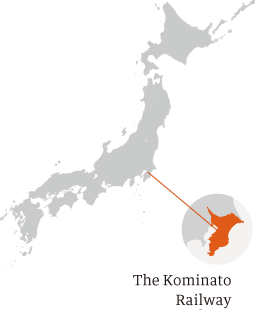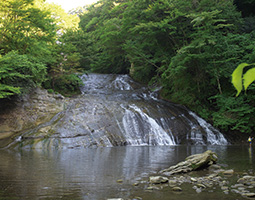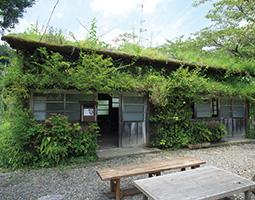Home > Highlighting JAPAN > Highlighting Japan October 2019 > A Trip by Local Train
Highlighting JAPAN
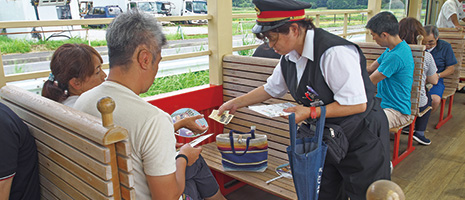
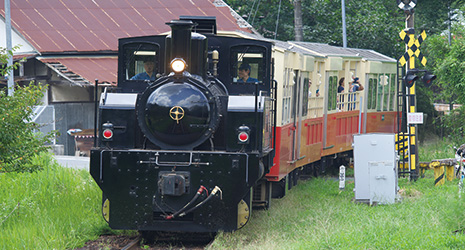
- PREVIOUS
- NEXT
A Trip through Satoyama with a Sprinkling of Modern Art
The Kominato Railway line in Chiba Prefecture takes passengers on a trip through age-old satoyama farmland, forests and waterfalls, and surprises them with works of modern art.
The Kominato Railway line connects Goi Station in Ichihara City on the west coast of the Boso Peninsula with Kazusa-Nakano Station in Otaki Town 39.1 km to the south. The journey of one hour and ten minutes passes through beautiful satoyama scenery in which mankind has long interacted with the natural environment, although Ichihara is only about an hour from central Tokyo.
The countryside along the line is one of the railway’s major attractions, with rapeseed and cherry blossoms ubiquitous in the spring, green rice filling the paddy fields in the summer and forest leaves turning red and yellow in the fall.
The sightseeing train Boso Satoyama Torocco, which began operating on the line in 2015, enables passengers to enjoy the cultivated scenery unobstructed, having two observation trolleys with glass ceilings and partially open sides. The train also has two standard carriages and a diesel locomotive modeled on a steam engine that used to run on the line. The train makes two or three round trips a day, four or five days a week mainly during the holidays, between Kazusa-Ushiku Station halfway down the line and Yorokeikoku Station near the Kazusa-Nakano terminus. The train runs at a slow speed of around 25 kph. Passengers are greeted along the way by station attendants and by pedestrians walking along the line waving and smiling. At Satomi Station, where the train stops for several minutes, local people sell vegetables and other foods and drinks on the platforms on weekends and holidays.
Kominato Railway began operating the line between Goi Station and Satomi Station in 1925, and the full route opened in 1928. Many facilities, such as the wooden station buildings, tunnels and bridges, appear today as they did when the railway line opened. Ten stations including Kazusa-Ushiku Station, Satomi Station, Tsukizaki Station and Yorokeikoku Station and the bridge over the Yoro River were selected as national registered tangible cultural properties in 2017. The structures blend seamlessly into the satoyama scenery and are often used as locations for TV commercials and dramas.
There are a variety of sightseeing spots along the Kominato Railway line. The Yorokeikoku valley is a popular destination for leisure activities such as hot spring bathing, hiking and camping. A number of large and small waterfalls can be seen from the hiking track along the Yoro River. Awamata no taki, one of these waterfalls, flows gently down a rock surface about 100 meters long and looks beautiful against the background of red leaves from late November to early December.
Art is another attraction of the Kominato Railway line. The international art festival Ichihara Art × Mix was held in Ichihara City in 2014 and 2017 with locations along the line serving as the main venues. At these art festivals, art projects utilizing local resources such as a disused elementary school, station buildings, cars, nature and food, were implemented with the aim of revitalizing the local communities. Some of the works exhibited at past art festivals have become fixtures in the local communities. Mori-radio Station, for example, which adjoins Tsukizaki Station, is a work created by artist Takahito Kimura at the art festival in 2014. The roof and walls of a building formerly used by railway workers are covered with more than sixty types of wild grass and moss. The roof has a window of polarized glass, and on sunny days light pours into the room in the colors of the rainbow.
Toilet in Nature by Sou Fujimoto, a world-famous architect, is a work located close to Itabu Station. The installation features a glass toilet cubicle behind high black fences on a roofless site of about 200 square meters. Cherry, plum and rapeseed flowers bloom on the site in spring. The toilet is for women only.
Ichihara Art × Mix 2020 will be held again as part of the Japan Cultural Expo from March to May 2020. Trains on the Kominato Railway line, which will transport passengers through satoyama during this spring blossom season, will themselves seem like works of art.
- PREVIOUS
- NEXT
© 2009 Cabinet Office, Government of Japan
